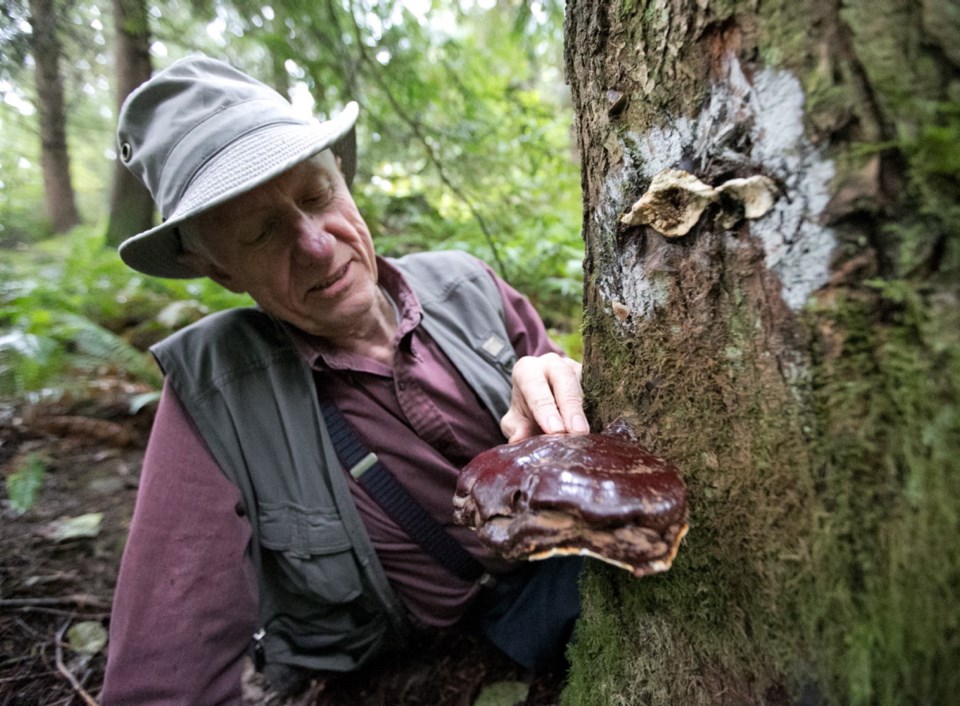An old saying holds that “There are old mushroom pickers and there are bold mushroom pickers, but there are no old, bold mushroom pickers.”
It’s a good reminder of the caution that’s necessary when collecting wild mushrooms to eat, experts say.
After all, one species found on Vancouver Island, the “death cap” — Amanita phalloides — can be deadly, destroying your liver in about three days.
Another, Smith’s amanita — Amanita smithiani — causes kidney failure, although patients usually recover in two to six weeks.
But despite these dangers, for the next two months, during fall’s mild, rainy weather, mushroom lovers and fungi enthusiasts will be out looking for specimens. And experts warn: If you want to take part and you want to taste them, don’t go into the woods alone.
“It’s not as simple as picking up a guide book,” said Richard Hebda, botanist at the Royal B.C. Museum.
“You should go out with [an expert] who really knows their mushrooms.”
Hebda and others say fungus experts — mycologists — will take into account many more factors than appearance to identify a wild mushroom. Terrain, surrounding environment, species of nearby trees, available sunlight, even the time of year and day can play a part.
Kem Luther, a member of the Southern Vancouver Island Mycological Society, whose members regularly lead mushroom hunts, said books capture only the look of one particular mushroom at one particular moment.
The same species can look very different at a different time.
Worse for novice mushroom hunters is the existence of look-alike varieties, so what might look safe might actually make you ill.
Luther said the death cap mushroom, for example, resembles an edible mushroom found in Asia, the paddy straw mushroom. He said a relatively large number of death cap poisonings occur in B.C., with Asian pickers usually making the mistake.
Similarly, Smith’s amanita can be found in the same places as the sought-after pine mushroom.
For this reason, mycologists group even edible mushrooms into categories: safe and unsafe.
“So the pine mushroom would be an unsafe edible because it looks like the Smith’s amanita,” Luther said.
He would also rank as unsafe the magic mushroom, Psilocybe semilanceata. Now illegal but still hunted for it hallucinogenic properties, magic mushrooms also have several poisonous look-alikes, often growing in the same ecological zones.
“[Magic mushrooms] are small, brown and not very fleshy so you have to pick a lot of them,” Luther said. “And there are a lot of small brown mushrooms out there.”
In all, he said about 2,000 species of mushrooms and fungus have been recorded on Vancouver Island, and it’s agreed at least another 2,000 have not been recorded.
Most of them are not poisonous so dangers can be overblown. But neither are the majority regarded as very tasty.
“I suppose they are edible but they aren’t very interesting,” Luther said. “I mean, even cardboard could be considered edible.”
He estimates there are a dozen mushroom species on Vancouver Island worth eating, but only five are regularly hunted.
• Chanterelles
“Everybody seems to know a little bit about chanterelles,” Luther said. “You can even buy them [wild harvested ones] in the store.”
• King bolete
“It can be quite big,” he said. “Unfortunately, when it gets really big it is usually infested with maggots.”
• Oyster mushrooms
With a thin cap, it cooks quickly and is torn into pieces and added to stir-fry dishes.
• Lobster mushrooms
Named because they are similar in colour to cooked lobster.
• Cauliflower mushroom
“It’s quite large and tasty and actually looks more like a plate of noodles all thrown together more than a cauliflower,” Luther said.
In contrast to the store-bought button mushroom, which he said most fungi enthusiasts would dismiss out of hand, these wild mushrooms all have a distinct, often powerful flavour.
In fact, he said the button mushroom was chosen for his bland, inoffensive flavour. Also, whether you buy white, brown or portobello mushrooms, they are all different varieties of the same species, Agaricus bisporus.
“People in mycological societies will eat the button mushroom but they don’t hold them in very high regard,” Luther said.
Fungi lovers join mycological societies and enjoy mushrooms for many more reasons than just eating.
Richard Winder, forest biologist with Natural Resources Canada, Pacific Forestry Centre, said most mycology enthusiasts initially join a mushroom club wanting to understand edibles. But after learning a handful of edibles, they continue on with mycology as a hobby because it offers so much more.
Fungi can be wildly shaped with brilliant colours and make great subjects to photograph.
Published checklists are available of species to work through and record finds. Specimens can be collected for scientific purposes, or for drying and display at home.
“Sometimes it’s just about appreciating the wide variety of things that are out there,” Winder said.
“Besides, it’s a good excuse to get out and stomp around and look at a different aspect of nature and enjoy its diversity.”
To find more about wild mushrooms, photos, checklists and information about upcoming outdoor forays, go to the South Vancouver Island Mycological Society website at svims.ca.



